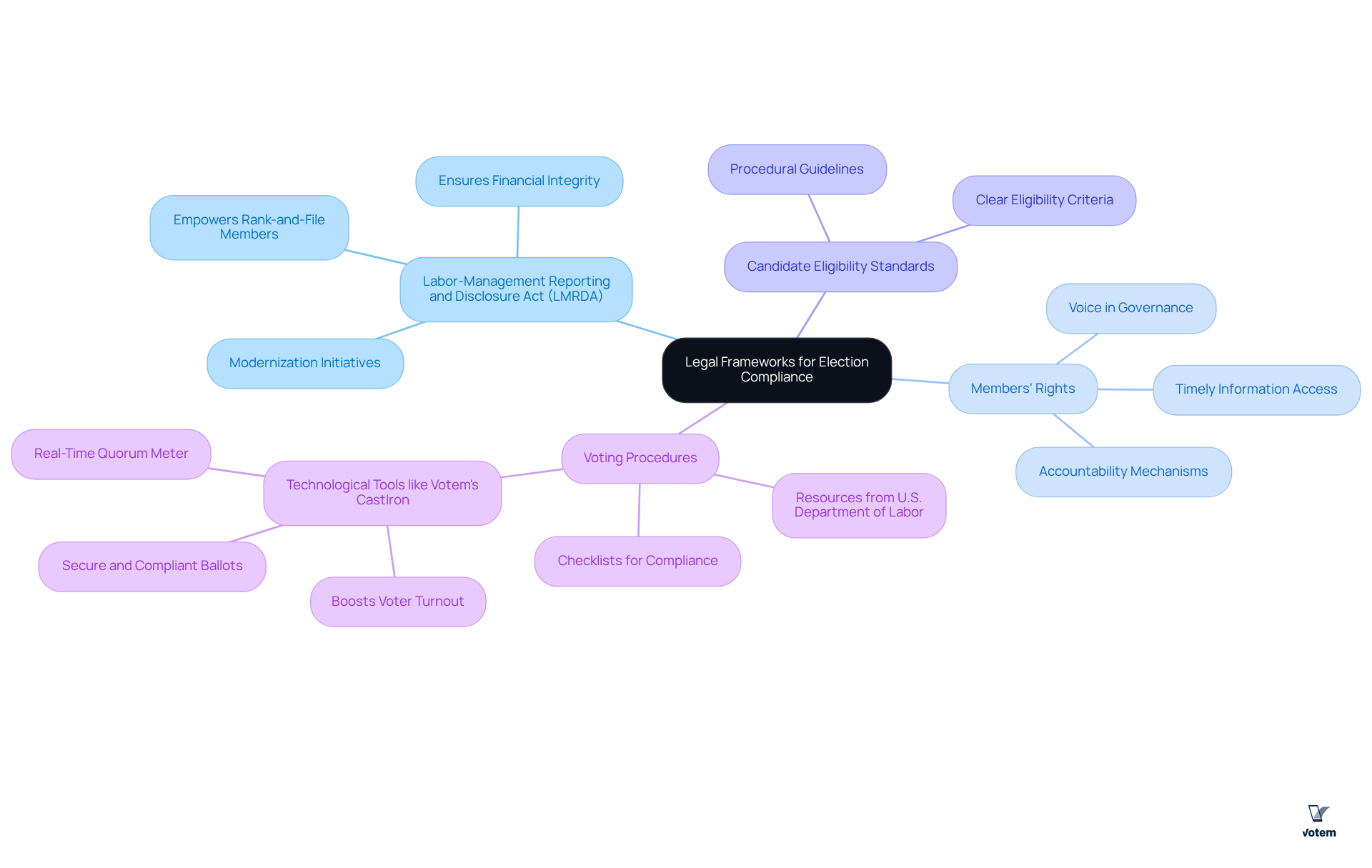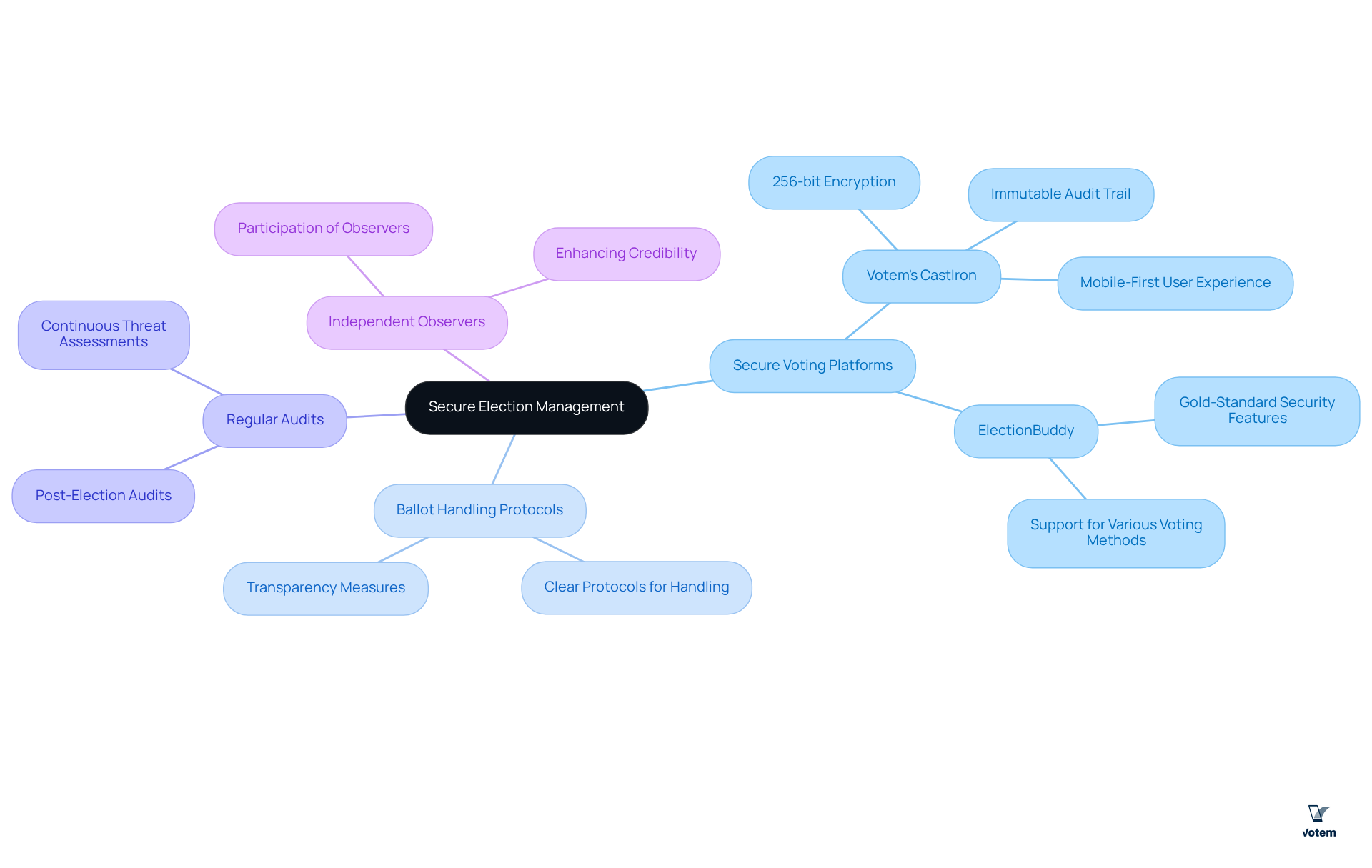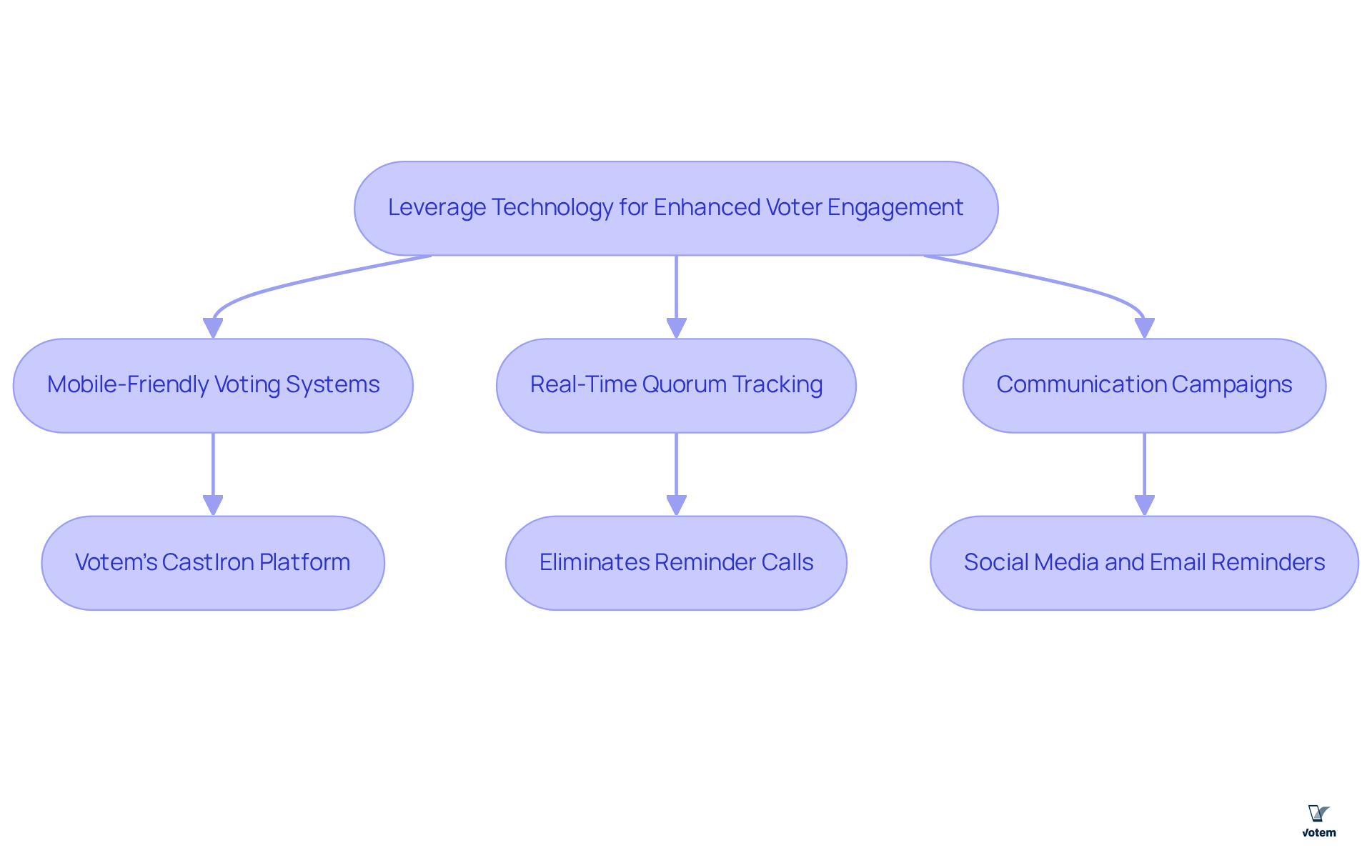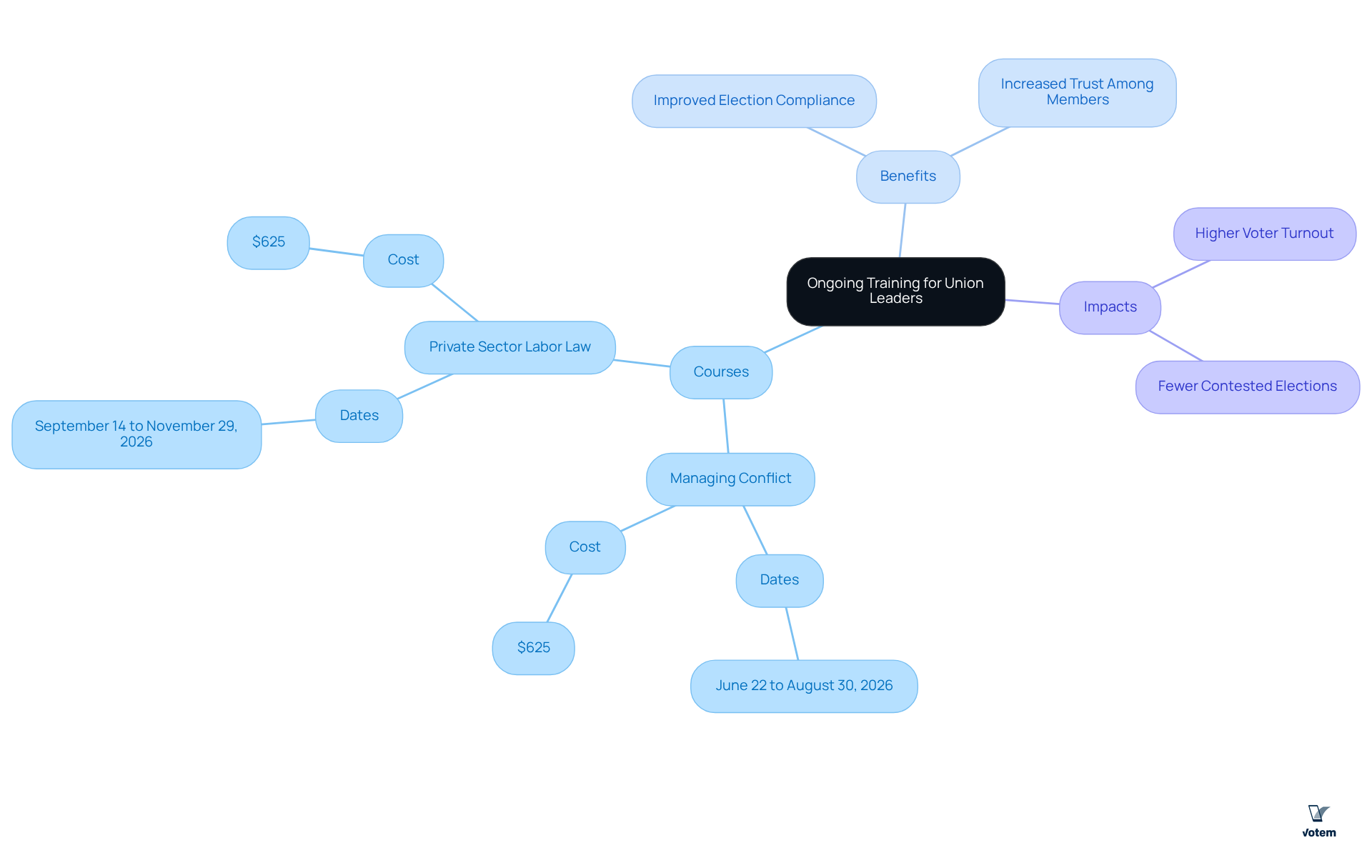Overview
The article delineates five pivotal strategies for achieving effective election compliance within unions, underscoring the necessity of comprehending legal frameworks, adopting secure management practices, utilizing technology to enhance voter engagement, and emphasizing the importance of continuous education for union leaders. These strategies collectively bolster transparency, security, and participation in the electoral process. They equip union leaders with the essential tools and knowledge to navigate complex regulations while fostering trust among their members.
Furthermore, understanding the legal landscape is crucial for union leaders. By grasping the intricacies of electoral laws, they can ensure compliance and mitigate risks associated with non-adherence. In addition, implementing secure management practices safeguards the integrity of the electoral process, instilling confidence among union members.
Moreover, leveraging technology for voter engagement transforms the electoral experience. By utilizing digital platforms, unions can facilitate easier access to voting resources, thereby increasing participation rates. This technological integration not only streamlines the process but also engages younger members who are more inclined to interact through digital means.
Lastly, prioritizing ongoing education for union leaders is essential. Continuous learning equips them with the latest information and best practices, enabling them to adapt to evolving electoral landscapes. By investing in education, unions can cultivate knowledgeable leaders who are prepared to address challenges head-on and inspire confidence among their members.
In conclusion, these strategies are not merely recommendations; they are imperative for fostering a compliant and participatory electoral environment within unions. Union leaders are encouraged to adopt these practices to enhance their electoral processes and build stronger relationships with their members.
Introduction
Navigating the intricate landscape of union elections requires more than a basic understanding of voting procedures; it demands a commitment to compliance and transparency. Effective election compliance safeguards the integrity of the electoral process and empowers members, fostering trust and accountability within the organization. However, with evolving regulations and the increasing complexity of voting technology, how can union leaders ensure they are compliant while enhancing voter engagement? This article explores five essential strategies that unions can implement to achieve effective election compliance, ensuring a robust democratic process that resonates with every member.
Understand Legal Frameworks for Election Compliance
Union leaders must possess a thorough understanding of the and other pertinent regulations governing voting procedures. This knowledge includes a clear grasp of members’ rights, candidate eligibility standards, and the . The , including a guide on conducting local officer elections, which outlines critical checklists and procedural guidelines. By adhering to these legal frameworks, organizations not only safeguard themselves against potential disputes but also significantly enhance and the legitimacy of their electoral processes.
Adherence to the LMRDA is crucial, as it empowers , ensuring they have a substantial voice in governance and decision-making. Recent initiatives underscore the necessity for transparency and accountability, thereby reinforcing the importance of these regulations in fostering trust within the organization. As , aptly stated, “Too often, rank-and-file workers lack the timely information and meaningful voice they need to hold elected leaders accountable for both fiscal and political decisions.”
Furthermore, as organizations navigate the complexities of election compliance, utilizing technology such as can streamline the process. This ensures , which can on launch day and enhance confidence in the electoral process.

Implement Best Practices for Secure Election Management
To ensure safe governance management, organizations must adopt a comprehensive strategy that encompasses , such as . This platform not only encrypts ballots but also provides an , which is essential for maintaining .
Furthermore, establishing is crucial to prevent tampering and ensure transparency. Regular audits, coupled with the participation of independent observers, can significantly .
By emphasizing security, associations can effectively and reassure participants of the integrity of their voting processes.

Leverage Technology for Enhanced Voter Engagement
Unions must harness technology to enhance , particularly through that empower individuals to cast their votes conveniently from any location. A prime example of this is , which has effectively managed over 13 million votes and is tailored for mobile use, achieving a remarkable increase in by up to three times on launch day.
Furthermore, essential features such as facilitate tracking participation and have eliminated the necessity for last-minute reminder calls, thereby streamlining the .
To further bolster participation, organizations should leverage social media and email campaigns to remind members about and the significance of their ballots. By emphasizing accessibility and effective communication, along with utilizing Votem’s , unions can significantly enhance participation rates and strengthen within their organizations.

Prioritize Ongoing Training and Education for Union Leaders
Union leadership must prioritize that respond to the evolving landscape of voting regulations and best practices. Engaging in workshops, webinars, and leveraging resources from reputable organizations, such as the U.S. Department of Labor, equips leaders with . For instance, the offers courses designed to enhance negotiation and leadership abilities, directly influencing the management of votes. Each course is priced at $625, representing an affordable investment for labor organizations.
Furthermore, the following courses are scheduled:
- : June 22 to August 30, 2026
- : September 14 to November 29, 2026
By investing in the education of group representatives, organizations cultivate a culture of adherence and transparency, crucial for implementing . Continuous training has been shown to significantly improve within organizations, as are better equipped to navigate complex regulations and execute efficient voting procedures.
Labor relations experts assert that such training not only enhances election compliance but also fosters trust among members, ultimately leading to increased and fewer contested elections. Votem’s capabilities, having managed over 13 million votes, emphasize the critical role of in the context of ongoing education for union leaders.

Conclusion
Effective election compliance within unions is essential for fostering a transparent and accountable governance structure. By understanding the legal frameworks, implementing best practices, leveraging technology, and prioritizing ongoing education, union leaders can significantly enhance the integrity of their electoral processes. These strategies not only protect the rights of members but also empower them to participate actively in union governance.
Throughout the article, key insights have been discussed, emphasizing the importance of adhering to the Labor-Management Reporting and Disclosure Act (LMRDA), utilizing secure voting platforms like Votem’s CastIron, and ensuring that union leaders engage in continuous training. Each of these elements plays a critical role in building trust, increasing voter turnout, and minimizing the risk of contested elections. Furthermore, by embracing these practices, unions can create a more robust electoral framework that genuinely reflects the will of their members.
In conclusion, the significance of effective election compliance cannot be overstated. Union leaders are called to take action by adopting these strategies to foster an environment of trust and participation. By prioritizing education and technology, unions can not only meet regulatory requirements but also enhance democratic practices within their organizations. Embracing these approaches will ultimately lead to stronger unions, where every member’s voice is valued and heard.
Frequently Asked Questions
What is the Labor-Management Reporting and Disclosure Act (LMRDA)?
The LMRDA is a regulation that governs voting procedures and ensures that union members have rights and a voice in governance and decision-making within their organizations.
Why is it important for union leaders to understand the LMRDA?
Understanding the LMRDA is crucial for union leaders as it helps them ensure compliance with voting procedures, safeguard against disputes, and enhance the legitimacy of electoral processes.
What resources does the U.S. Department of Labor provide for election compliance?
The U.S. Department of Labor provides resources such as a guide on conducting local officer elections, which includes critical checklists and procedural guidelines for ensuring election compliance.
How does adherence to the LMRDA benefit union members?
Adherence to the LMRDA empowers rank-and-file members by ensuring they have a meaningful voice in governance and the ability to hold elected leaders accountable.
What recent initiatives highlight the need for transparency and accountability in unions?
Recent initiatives emphasize the importance of transparency and accountability in union governance, reinforcing the necessity of regulations like the LMRDA to foster trust within organizations.
How can technology assist in election compliance for unions?
Technology, such as Votem’s CastIron platform, can streamline the election process by ensuring secure and compliant ballots, which can significantly increase voter turnout and enhance confidence in the electoral process.
List of Sources
- Understand Legal Frameworks for Election Compliance
- Labor Department announces self-auditing tools to help employers comply with federal laws (https://mcknightsseniorliving.com/news/labor-department-announces-self-auditing-tools-to-help-employers-comply-with-federal-laws)
- LMRDA — News & Updates — UFCW 3000 (https://ufcw3000.org/news/tag/LMRDA)
- US Department of Labor launches self-audit programs to help regulated community strengthen compliance with federal labor laws (https://dol.gov/newsroom/releases/osec/osec20250724)
- edworkforce.house.gov (https://edworkforce.house.gov/news/documentsingle.aspx?DocumentID=412507)
- Department of Labor Launches Self-Audit Programs for Employers, Unions, and Benefit Plan Administrators (https://workcare.com/resources/article/department-of-labor-launches-self-audit-programs-for-employers-unions-and-benefit-plan-administrators)
- Implement Best Practices for Secure Election Management
- electionbuddy.com (https://electionbuddy.com/blog/2024/10/09/security-issues-in-labor-union-voting)
- Election Security (https://brennancenter.org/election-security)
- Best Practices for Securing Election Systems | CISA (https://cisa.gov/news-events/news/best-practices-securing-election-systems)
- Cybersecurity Agency Ends Support to Election Security Program (https://democracydocket.com/news-alerts/cybersecurity-agency-ends-support-to-election-security-program)
- Leverage Technology for Enhanced Voter Engagement
- Amazon faces union vote at North Carolina warehouse (https://reuters.com/technology/amazon-faces-union-vote-north-carolina-warehouse-2025-02-10)
- Tech for Civic Engagement – Rock the Vote (https://rockthevote.org/programs-and-partner-resources/tech-for-civic-engagement)
- Home – Voatz secure and convenient voting anywhere (https://voatz.com)
- Union Voting: The Election Platform for Unifying Your Union Members! – ElectionBuddy (https://electionbuddy.com/customers/unions)
- 2024 Impact Report Showcases a Year of Innovation and Voter Engagement | Democracy Works Blog (https://democracy.works/news/2024-impact-report-showcases-a-year-of-innovation-and-voter-engagement)
- Prioritize Ongoing Training and Education for Union Leaders
- P.O.R.T. Gives Union Members the Tools They Need to Win Regardless of Next Year’s Election Results (https://afge.org/article/port-gives-union-members-the-tools-they-need-to-win-regardless-of-next-years-election-results)
- Education (https://ibew.org/our-departments/education)
- Digital Trainings | AFL-CIO (https://aflcio.org/what-unions-do/resources-union-activists/digital-trainings)
- Union Leadership | The ILR School (https://ilr.cornell.edu/programs/professional-education/topic/union-leadership)
- IAFF hosts 2025 Communications and Political Training Academies – IAFF (https://iaff.org/news/iaff-hosts-2025-communications-and-political-training-academies)

